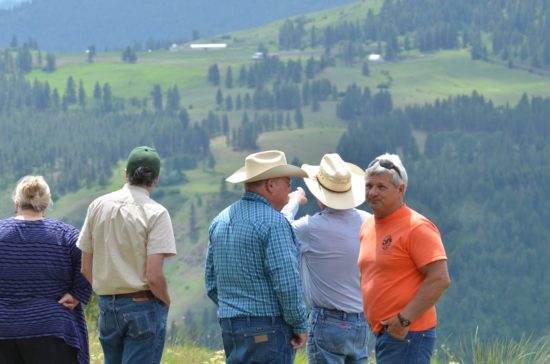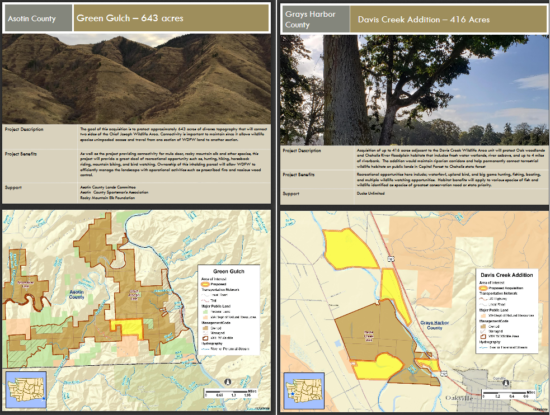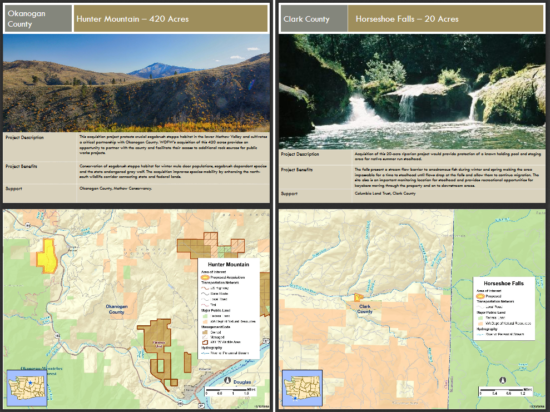
18 WDFW Fish, Wildlife, Recreation Acquisition Proposals Out For Comment
Washington land managers have their eyes on nearly 7,000 acres across the state for fish and wildlife habitat, angling, hunting and other recreational uses and are asking for comment on them.
The 18 proposals range from padding wildlife areas and purchasing inholdings in Eastern Washington to conserving and restoring Puget Sound estuaries to strategic partnerships with counties and improved access to salmon streams.

“Our goal is to protect land and water for people and wildlife throughout the state while preserving natural and cultural heritage,” said WDFW lands manager Cynthia Wilkerson in a press release.
They’re all far from done deals. Public input over the next three weeks will help determine which will move forward to be competitively ranked against other agencies’, cities’, counties’ and organizations’ proposals. Funding would be sought through state and federal grants for recreation, habitat and endangered species.
WDFW’s 2020 wish list is more than twice as long as last year’s and it’s notable for several proposals.
A 420-acre property in the lower Methow valley would not only protect “crucial sagebrush steppe habitat” for mule deer and other species, but help “(cultivate) a critical partnership with Okanogan County.”
That county is one of the last best places to do big things in terms of wildlife habitat, but local commissioners and residents have also bristled about state land buys and their impacts to tax rolls.
Buying the ground on top of a bench above the tiny town of Methow would allow WDFW to “partner with the county and facilitate their access to additional rock sources for public works projects.”
The project has the support of Okanogan County, the agency notes.

Other big acquisitions include a quartet in extreme Southeast Washington.
The largest is 1,650 acres on Harlow Ridge, which includes a series of flats and timbered draws between upper South Fork Asotin and George Creeks west of Anatone.
Adjacent to the Asotin Creek Wildlife Area, it would protect elk winter range and calving areas, as well as “rare and imperiled remnant prairie habitats and endemic plants.”
“Department staff have been responding to elk damage in the Cloverland area and the purchase of this property would help to alleviate damage issues by providing alternate forage,” WDFW adds.
It has support from the Asotin County Sportsmen’s Association and Rocky Mountain Elk Foundation.
The 643-acre Green Gulch buy would link sections of the Chief Joseph Wildlife Area on the west side of the divide between Hells Canyon and Joseph Creek, “providing connectivity for mule deer, Rocky Mountain elk and other species” and “a great deal of recreational opportunity such as, hunting, hiking, horseback riding, mountain biking, and bird watching.”
RMEF, the sportsmen’s association and the Asotin County Lands Committee all support it.
The pro-hunting and -elk organization also gives the thumbs up to adding another 770 acres to the spectacular 4-O Wildlife Area, purchased in chunks earlier this decade from rancher Mike Odom. If approved it would bring the unit along and above the Grande Ronde River to 11,234 acres, or 17.5 square miles.
A bit further west is a 720-acre patch that butts up against the Umatilla National Forest and which WDFW would like to add to the Grouse Flats Wildlife Area.
“The property is heavily used by elk, deer, bears, cougars, and wolves with many non-game species present. Numerous springs, wetlands, and Bear Creek on the property will continue to provide quality riparian habitat that should improve over time in public ownership,” WDFW states.
Recent pics from a site evaluation show it might need some cleaning up. RMEF supports the buy.

In Yakima County is a 1,105-acre parcel on the west side of Wenas Lake that WDFW is looking at for as a habitat conservation easement and Wenas Wildlife Area headquarters.
It’s supported by birders and a conservancy.
In Grays Harbor, the agency would like to add as much as 416 acres in three parcels to the Davis Creek Wildlife Area, a former dairy farm, along the Chehalis River just downstream of Oakville. It has support from Ducks Unlimited and would protect the floodplain.
WDFW would also like to resecure access to popular Chapman Lake in western Spokane County following the closure of a resort with the only launch in 2011, as well as acqiure surrounding uplands. The lake is noted for kokanee and largemouth fishing, and the parklike lands and ponds above it look gamey.
“The intent is to purchase road access and a small lakefront footprint with exsisting grant funds and pursue funding for a land exchange or purchase of the remaining property in this section,” the agency explains.
Supporters include county commissioners and at least one local fly fishing club.
Another key access proposal is on the lower Samish River, up which plentiful hatchery fall Chinook return but getting to them can be difficult. Last year, anglers built a freelance boardwalk out of pallets to get to good spots — but which were also laid down on private land and had to be removed.

Buying the 109-acre property “will contribute significantly to improving fishing access that is in high demand,” according to WDFW.
A levee does bisect the land and is marked with signs barring access, so conversations would need to occur with the local diking district, according to Skagit Wildlife Manager Belinda Rotton.
Still, she’s excited about the proposal, as it could help expand waterfowl hunting opportunities and access to harvestable salmon.
“When we heard it was available, ‘Oh my goodness,’ this will be a good property for us,” she said.
Skagit County supports the proposal.
Other proposals target the Union River and Discovery Bay estuaries, land surrounding a holding pool for summer steelhead on the East Fork Lewis River, a Skamania County bat cave, a 50-acre addition to the Ebey Island Wildlife Area, 2.5 acres around the Modrow Bridge launch on the Kalama, an acre at the old Peshastin Mill for a parking lot for a trail, and inholdings or parcels adjacent to the Rendezvous Wildlife Area of the upper Methow Valley and Quincy Lakes Wildlife Area west of Ephrata.
Following public review, WDFW Director Kelly Susewind would sign off on a list of projects for seeking funding. Typical sources include the state Capital Budget disbursed through the Washington Recreation and Conservation Office and from the U.S. Fish and Wildlife Service’s various granting mechanisms, including for endangered species.
WDFW owns and/or manages more than a million acres across Washington for fish, wildlife and recreation.
Comments are being taken from today till Jan. 3. Send them via email to lands@dfw.wa.gov or via the Post Office to Real Estate Services, PO Box 43158, Olympia, WA 98504.
